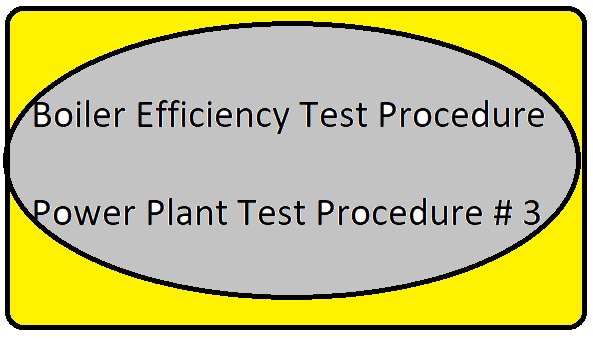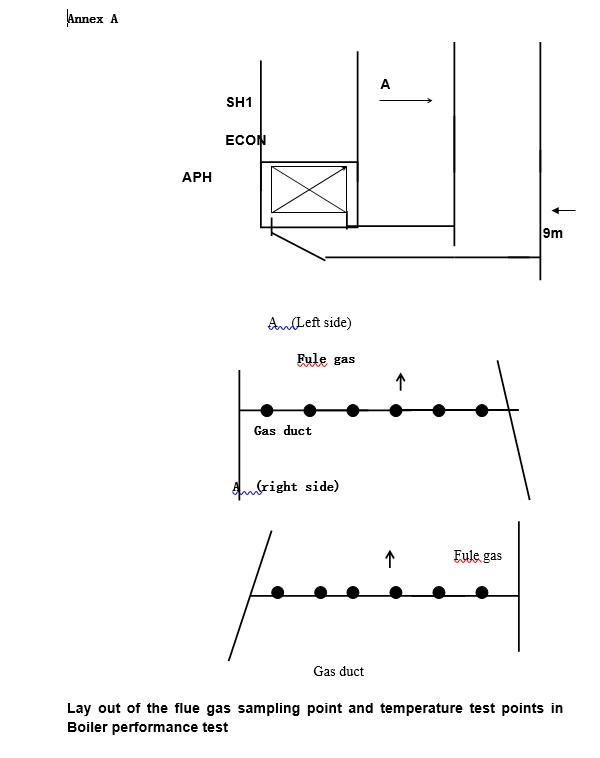Boiler Efficiency Test Procedure
Summary
In case if boiler is Natural circulation, double passes, balanced draft, single reheat, with cyclone separator – Circulating Fluidized Bed Combustion type (CFBC), which burns high moisture and sulfur coal.
According to the requests of the equipment supply contract, after completion of satisfactory Reliability Run, the Supplier shall carry out the units Performance Guarantee Test. The test shall be carried out as soon as possible on a mutually agreed date. This PG test would check whether its running characteristic meets the contract requests to guarantee the boiler unit safely and economically running.
-
Compiling basis
1.2 Indian 135MW CFB unit
1.3 Boiler efficiency test code: ASME PTC4-1998
-
Boiler efficiency test items
boiler guaranteed efficiency:
Boiler efficiency :75.02 %(with 1% piping losses)
Boiler efficiency:75.82 % (without 1% piping losses)
-
Guaranteed value condition
according to the related items of the contract, the boiler property can reach the guaranteed value on the following condition:
3.1 Design coal should be used during the test as per the Contract;
3.2 Boiler should be operated according to operation and maintenance instructions offered by the Supplier. It will be carried out according to the requirements of operation regulations during the test
3.3 Thermal balance standard temperature is 32℃;relative humidity is 73%;atmosphere pressure is 98.3kPa; the boiler blowdown is 0.0%;
3.4 Calculation method of heat balance and calculation method of heat loss should abide by the standard “ASME PTC4”in principle.
3.5 The examination of boiler steam rate takes the measurement of main steam flow as the criterion;
3.6 Overall heat loss calculation of boiler includes the following items:
3.6.1 Dry flue gas loss
3.6.2 Heat loss due to moisture formed in hydrogen combustion in fuel
3.6.3 Heat loss due to moisture of fuel
3.6.4 Heat loss due to unburned carbon
3.6.5Heat loss due to radiation(use contract value 0.3%)
3.6.6Heat loss due to moisture in air
3.6.7 Heat loss of the bed loss
3.6.8 limestone calcine heat loss(use contract value 1.78 %)
3.6.9 Sulfur salinization heat loss(use contract value -2.07 %)
3.6.10 Immeasurable heat loss
-
Test methods and condition
Test methods and calculations of examination should abide by ASME PTC4 in principle.
4.1 Efficiency test of boiler adopts the anti-balance thermal method.
4.2 Correction curves are as follows:
Fuel Moisture Effect to Boiler Efficiency
Feedwater Temp Effect to Boiler Efficiency
Exhaust Gas Temp Effect to Boiler Efficiency
Fuel Calorific Value Effect to Boiler efficiency
Environment Temp Effect to Boiler Efficiency
Fuel Moisture Effect to Boiler Efficiency
4.3 The examination of boiler steam rate takes the measurement of main steam flow as the criterion.
4.4 During the test, there is no blowdown, no soot blowing.
4.5 The standard temperature of efficiency calculation is 32℃
4.6 Performance tests should be carried out under the design coal as following table:
Stable A: Coal analysis
| item | symbol | unit | design coal |
| moisture | Mt | % | 42 |
| receive based ash | Aar | % | 23 |
| receive based volatile | Var | % | 21 |
| receive based carbon | Car | % | 25.8 |
| receive based hydrogen | Har | % | 2.1 |
| receive based nitogen | Nar | % | 0.5 |
| receive based oxygen | Oar | % | 5.2 |
| receive based sulfur | St,ar | % | 1.4 |
| receive based GCV | Qar | Kcal/kg | 2600 |
Stable B: Limestone before calcine:
| item | symbol | unit | value |
| calcium carbonate | CaCO3 | % | 90 |
| Magnesium carbonate | MgCO3 | % | 1.47 |
| silicon dioxide | SiO2 | % | 1.15 |
| Aluminium(III)oxide | Al2O3 | % | 1.43 |
| iron(II) trioxid | Fe2O3 | % | 1.12 |
| moisture | H2O | % | 0.5 |
4.7 Flue gas temperature and analysis of flue gas adopt the grid method on equal-area principle.
4.8 The ratio of fly ash and bottom ash is in accordance with design value.
4.9 Properties of water and steam in SI-Units
4.10 Duration of formal test is 4 hours and the period of steady operation conditions before test is 1 hour.
4.11 At the beginning and the end of test, the following parameters should be recorded and kept the same basically:
Water level of drum
Main steam flow, temperature and pressure
Feedwater flow, feedwater temperature and pressure
Main parameters of combustion conditions
4.12 Before test, thermodynamic system should be isolated. Close auxiliary steam supply from boiler to the outside or from the outside to boiler, shut down steam air heater, close Periodic sewage valves and continuous blowdown valves.
Since the efficiency test is to examine whether the whole boiler can reach the contract requests, the boiler and auxiliary system should be fully checked before test and keep the boiler in good running state. Use soot blower to keep the heating surface clean before test.
5. Test content and requests
5.1 measure following parameter per 15min
(1) air pre-heater outlet flue gas analysis;
(2) flue gas temperature (air pre-heater outlet);
(3) atmosphere pressure and environment temperature;
5.2 Record following parameter data by DCS system per 5mins (detail list see annex table
- Load
- Main steam pressure, temperature and flow
- Main feedwater pressure, temperature and flow
- Amount of fired coal
- Inlet temperature of air preheater in flue-gas side
- Drum Level Feed Water T
- Air & flue gas side P,Flue gas side T ,O2%
5.3 Samples of raw coal(taking samples every 15 minutes), bottom ash (taking samples every 30 minutes) and Fly ash
5.3.1 Sample of raw coal is taken at the entrance of the coal feeder, there are 16 times in total for test duration (operation duration is 4 hours), and the sample weight of each time is about 2~3 kg. Get a final sample of coal by quartering process after taking samples during test. The final coal sample is not less than 5kg and is divided into three. One of samples will be sent to the recognized agency for the proximate analysis, analysis of High heating value and ultimate analysis (receive basis), another two samples is managed by VSLP and SEPCOIII separately for future reference.
5.3.2 Sample of fly ash is taken from the below of ESP hopper, there are 8 times in test duration (test duration is 4 hours), and the sample is about 0.5kg for each time. take a final sample through quartering process. The sample of fly ash is not less than 2kg and is divided into three. One of samples will be sent to the site laboratory for combustible analysis (carbon amount), another two samples is managed by VSLP and SEPCOIII separately for future reference.
5.3.4 Sample of bottom ash is taken from the outlet of slag cooler, there are 8 times in total for test duration (test duration is 4 hours), and the sample is about 0.5 kg for each time. According to quartering process, get a final sample. The sample of bottom ash is not less than 2kg and is divided into three. One of samples will be sent to the site laboratory for combustible analysis (carbon amount), another two samples is managed by VSLP and SEPCOIII separately for future reference.
-
Preparation work before test
6.1 the related parts should affirm and approve this test procedure before test;
6.2 the owner should apply for the power load dispatch ahead of time to meet the tes requirement;
-
The arrangement of the test measure point
7.1 The measure point of the air preheater outlet gas analysis sampling and temperature (as the point B in the picture): arrange 6 measure holes at the air preheater outlet flue (ascent part) laterally in grid way (the holes’ position can be seen on-site); there are altogether 12 measure holes on both flue sides. The specific method: firstly, open aΦ50 hole in the flue; then wedΦ50×3 common steel pipe whose length is better to stretch the insulating layer 50mm with plug.
7.2 The flying ash sampling measure point is at the outlet horizon section of the air preheater.
-
testing instruments
| No. | Equipment | Parameter | range |
| 8.2.1 | environment thermometer | Temp | 0—100 Degree C |
| 8.2.2 | Atmosphere pressure meter | P | 0—200Kpa |
| 8.2.3 | testo 608 H1 hygrometer | RH | +2—+98 %RH |
| 8.2.4 | T type thermocouple | Temp | 0—300 |
| 8.2.5 | Testo350XL gas analyzer | O2
CO NO NO2 SO2 |
0—+25% Vol.O2
0—+500 ppmCO 0—+300ppmNO 0—+500ppmNO2 0—+5000ppmSO2 |
| 8.2.6 | 3012H (LaoYing) | Sample Flow
Gas Dyna P Gas Static P Gas T Dry/Wet Bulb Temp |
(5~80)L/min
(0~2000) Pa (-30~+30) kPa (0~500) ℃ (0~100)℃ |
Boiler performance particulars is as following table:
| 1 | Superheater outlet steam,flow | T/hr. | 440 |
| 2 | Superheater outlet pressure | ata | 13.7 |
| 3 | Superheater outlet temperature | degree | 540 |
| 4 | Dry gas loss | % | 4.9 |
| 5 | Hydrogen moisture loss | % | 4.89 |
| 6 | Fuel moisture loss | % | 10.87 |
| 7 | Air moisture loss | % | 0.12 |
| 8 | Unburnt carbon loss | % | 2.2 |
| 9 | Radiation loss | % | 0.3 |
| 10 | Heat loss of bed ash | % | 0.75 |
| 11 | Heat loss of limestone calcinations | % | 1.53 |
| 12 | Heat loss due to sulphur retention | % | -1.78 |
| 13 | Unaccounted loss | % | 0.4 |
| 14 | Total heat loss | % | 24.18 |
| 15 | Boiler efficicency | % | 75.82 |
Annex C: Record boiler running parameter data list
| Time | ||||||||||||
| Load | ||||||||||||
| Main steam Flow | ||||||||||||
| RH steam Flow | ||||||||||||
| Feed water Flow | ||||||||||||
| FLOW of DEP | ||||||||||||
| Drum Level | ||||||||||||
| Feed Water T | ||||||||||||
| Steam side P | ||||||||||||
| Steam T | ||||||||||||
| Aia & flue gas side P | ||||||||||||
| Flue gas side T | ||||||||||||
| Feed water P | ||||||||||||
| Main steam outlet P | ||||||||||||
| RH Steam outlet P | ||||||||||||
| Furnace outlet T | ||||||||||||
| Wind room P | ||||||||||||
| Bed P | ||||||||||||
| SA P | ||||||||||||
| HP FAN outlet P | ||||||||||||
| RTN FDR | ||||||||||||
| Separtor inlet T | ||||||||||||
| Separtor outlet T | ||||||||||||
| A.H outlet T | ||||||||||||
| ID fan inlet T | ||||||||||||
| Separtor inlet P | ||||||||||||
| Separtor outlet P | ||||||||||||
| HT.SH inlet | ||||||||||||
| O2 | ||||||||||||
| Gas T | ||||||||||||
| CO | ||||||||||||
| Atmosphere P | ||||||||||||
| Atmosphere T | ||||||||||||
| Air Humidity | ||||||||||||
| Coal Sample | ||||||||||||
| Fly Ash Sample | ||||||||||||
| Bottome Ash Sample |


